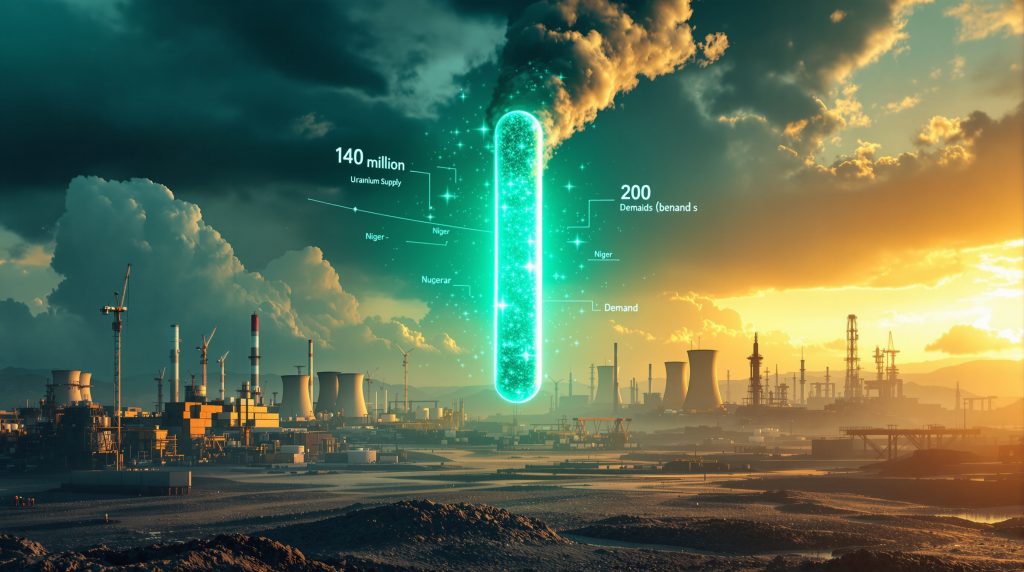Uranium Supply Crisis: Understanding the Investment Opportunity
The uranium market is experiencing a critical supply-demand imbalance that creates compelling investment opportunities for strategically positioned companies. Primary production of approximately 140 million pounds annually falls significantly short of global reactor requirements approaching 180-200 million pounds. This structural deficit is projected to accumulate to a staggering one billion pound shortfall over the next 15 years, creating unprecedented uranium market volatility fundamentally different from previous uranium cycles.
How Severe is the Current Uranium Supply Deficit?
According to the World Nuclear Association's 2024 World Uranium Mining Production report, global uranium production in 2023 was approximately 58,000 tonnes U (equivalent to ~152 million pounds U₃O₈), while reactor requirements are estimated at ~67,000 tonnes U annually. This gap continues to widen as secondary supplies from government stockpiles diminish and new mines fail to enter production.
Supply Disruption Factors Creating Investment Opportunity
- Global primary production has contracted dramatically following years of depressed pricing that made many operations uneconomical
- Kazakhstan (world's largest producer) has implemented production cuts amid political instability and resource nationalization concerns
- Niger's military coup has disrupted approximately 5% of global uranium supply, highlighting geopolitical risks in key production regions
- Secondary supplies from government stockpiles and recycled materials are rapidly depleting after years of filling primary production gaps
- Workforce capacity in the US uranium sector has collapsed by 98%, falling from 25,000 professionals in the 1970s to just 500-600 today
The severity of these supply constraints is further magnified by the industry's limited ability to respond quickly. Unlike many commodities, uranium production involves complex technical processes, strict regulatory requirements, and specialized expertise that cannot be rapidly developed or deployed.
Market Pricing Dynamics
Current spot prices in the $75-80/lb range remain insufficient to incentivize new project development, despite representing significant improvement from the $20-30/lb levels seen just a few years ago. Industry economics reveal a stark reality:
- Existing producers with legacy assets can operate profitably at $23-30/lb, providing substantial margins at current price levels
- Restart projects typically require $50-70/lb for economic viability
- Brownfield expansions need $80-100/lb for development economics
- Greenfield projects require approximately $150/lb to justify full-cycle investment returns
This pricing disconnect creates a fundamental market challenge: current prices allow existing producers to generate substantial cash flow while being insufficient to stimulate the new supply development necessary to meet growing demand.
Why is Nuclear Energy Demand Accelerating Now?
The global nuclear energy renaissance represents the most significant expansion since the initial adoption of civil nuclear technology in the 1960s-70s. This demand growth stems from converging factors creating sustained uranium consumption increases across multiple markets.
Energy Security Imperatives
Since the 2022 energy crisis following the Russia-Ukraine conflict, countries worldwide have reassessed their energy independence priorities with renewed focus on nuclear power:
- European nations including Belgium, Germany, and the Netherlands have reversed or extended nuclear phase-out policies
- Japan has accelerated reactor restarts, with approximately 12 units back online since the Fukushima incident and more scheduled for return
- France has announced plans to build 14 new reactors while extending the operational lives of existing plants
- The UK has committed to significant nuclear expansion including both large-scale plants and SMR deployment
China's nuclear expansion remains the most ambitious globally, with over 50 reactors under construction and plans for 150+ reactors by 2035 according to the World Nuclear Association. This represents the largest nuclear build program in history and will significantly increase global uranium requirements.
Climate Change Mitigation Requirements
Nuclear power's role in addressing climate change has gained widespread recognition, transforming from environmental liability to essential clean energy source:
- Nuclear provides consistent 24/7 baseload generation crucial for grid stability as intermittent renewables increase
- Life-cycle carbon emissions from nuclear power are comparable to wind and solar at approximately 12g CO₂/kWh according to IPCC assessments
- Modern reactor designs achieve operational lifespans of 80+ years, dramatically improving carbon economics and resource efficiency
- Nuclear plants require minimal land use compared to equivalent renewable capacity, reducing environmental footprint
This recognition has transformed public perception, with growing acceptance of nuclear energy as an essential component of decarbonization strategies rather than a controversial technology to be phased out.
Emerging Demand Sources
Beyond traditional utility applications, new demand sources are emerging that could significantly increase uranium consumption:
- Data center electricity consumption is creating unprecedented power requirements, with AI development facilities requiring 1-2 gigawatts of stable baseload power
- Small Modular Reactor (SMR) commercialization is accelerating with multiple designs entering regulatory approval phases and deployment expected by 2027-2028
- Industrial heat applications are expanding uranium use beyond electricity generation to include hydrogen production, desalination, and process heat
- Advanced reactor designs are being developed for specialized applications including remote power, marine propulsion, and space exploration
These emerging applications represent potential step-change increases in uranium demand that existing supply forecasts may not adequately capture.
What Political Factors are Reshaping the Uranium Market?
Unprecedented bipartisan political support for nuclear energy has created a favorable policy environment that strengthens the investment case for uranium producers and developers across Western democracies.
Russian Supply Reduction Initiatives
Western nations are actively working to reduce dependence on Russian nuclear fuel supplies:
- The Prohibiting Russian Uranium Imports Act targets elimination of Russian uranium imports by 2027-2028
- European utilities are seeking alternative supply sources amid geopolitical tensions and energy security concerns
- Western conversion and enrichment capacity expansion is receiving government support to replace Russian capabilities
- Security of supply premiums are emerging in contract negotiations, with utilities willing to pay higher prices for reliable non-Russian supply
These initiatives directly benefit Western uranium producers and developers operating in stable jurisdictions, creating premium pricing opportunities and preferred offtake arrangements. The US ban on Russian uranium is expected to significantly reshape global supply chains in the coming years.
Domestic Production Incentives
Multiple government programs now support domestic uranium production and nuclear fuel cycle development:
- Critical minerals strategies across Western nations now incorporate uranium as a strategic resource
- Permitting reform efforts are prioritizing nuclear fuel cycle projects to accelerate development timelines
- The Inflation Reduction Act includes production tax credits for nuclear energy generation
- Government funding programs are supporting workforce development and technical capacity rebuilding
These supportive policies represent a fundamental shift from previous regulatory environments that often impeded nuclear energy development, creating more favorable conditions for investment and project advancement.
Financial Institution Policy Shifts
Traditional financing barriers to nuclear projects are rapidly disappearing:
- The World Bank has reversed its decades-long prohibition on nuclear project financing
- ESG frameworks increasingly recognize nuclear's role in climate mitigation, removing previous exclusion criteria
- Institutional investors are reevaluating nuclear exclusion policies as climate benefits gain recognition
- Sovereign wealth funds from energy-producing nations are establishing strategic uranium positions
These financial policy changes significantly improve capital access for uranium producers and nuclear developers, reducing financing costs and expanding investor participation.
What Technical Challenges Limit New Uranium Supply?
The uranium sector faces significant technical constraints that limit rapid supply expansion, creating barriers to entry that benefit established producers while extending the timeline for market rebalancing.
Workforce Capacity Constraints
The 98% reduction in US uranium workforce from 25,000 to 500-600 professionals has created severe knowledge gaps:
- Critical expertise has been lost as experienced personnel retire without knowledge transfer
- Specialized roles require multi-year training programs to develop necessary skills
- Educational institutions have reduced or eliminated programs producing qualified graduates
- Competition for limited technical talent drives up operating costs and extends project timelines
This workforce limitation represents perhaps the most significant barrier to rapid production expansion, as technical knowledge cannot be quickly replaced regardless of capital availability or uranium pricing.
Operational Restart Challenges
Multiple companies have encountered significant difficulties in restart operations:
- Mill commissioning delays have extended restart timelines beyond initial projections
- Permitting processes have proven more complex than anticipated, particularly for operations dormant for extended periods
- Equipment availability constraints after years of industry contraction limit replacement and upgrade options
- Technical expertise shortages have led to operational inefficiencies and production shortfalls
These restart challenges demonstrate that uranium production involves complex technical processes that cannot simply be activated in response to higher prices, unlike some commodity markets where production can quickly respond to price signals.
Infrastructure Requirements
The uranium production chain requires specialized infrastructure that represents significant capital investment:
- Processing facility scarcity creates competitive advantages for existing operators, with limited milling capacity available in most jurisdictions
- Transportation logistics require specialized handling capabilities for radioactive materials, limiting service provider options
- Technical service providers operate at capacity limits after years of industry contraction
- Laboratory and analytical capacity constraints affect exploration programs and operational quality control
These infrastructure limitations create significant barriers to entry and competitive advantages for companies with existing operational assets.
How are Leading Companies Positioned in this Market?
Companies with specific operational advantages maintain significant competitive positioning in the current market environment, creating investment opportunities based on technical execution capabilities rather than promotional activities.
Established Producer Advantages
Operating producers maintain substantial cost and operational advantages:
- Energy Fuels reports operating costs of $23-30/lb at its White Mesa Mill facility, compared to greenfield development requirements exceeding $150/lb
- Fully permitted and operational processing infrastructure provides immediate production capability without development delays
- Established technical teams with operational experience enable efficient production scaling
- Existing customer relationships and marketing channels facilitate premium pricing and contract terms
These advantages translate into immediate cash flow generation at current uranium prices while competitors struggle with development timelines and financing challenges.
Advanced Explorer Positioning
Well-positioned exploration companies demonstrate technical execution that distinguishes them from promotional entities:
- Systematic exploration approaches with high technical standards show consistent results
- Exceptional drill success rates indicate technical team capabilities and project quality
- Strategic land positions in tier-one jurisdictions provide permitting advantages and infrastructure access
- Technical teams with proven discovery track records enhance project advancement capabilities
These exploration advantages significantly improve development probability and reduce timeline risk, factors increasingly valued by investors and potential acquirers.
Jurisdictional Premium Factors
Companies operating in stable mining jurisdictions maintain significant valuation advantages:
- Operations in Canada, Australia, and the United States command 30-50% valuation premiums compared to jurisdictions with higher political risk
- Permitting certainty creates development timeline advantages crucial for project economics
- Infrastructure access reduces capital requirements and operational costs
- Political support provides regulatory certainty and potential government partnership opportunities
These jurisdictional advantages have become increasingly important as geopolitical tensions impact global supply chains and resource nationalism concerns grow in certain uranium-producing regions.
What Investment Models are Emerging in Uranium?
The uranium market presents multiple approaches to sector participation, each with distinct risk-reward profiles and exposure characteristics suited to different investor objectives. Developing effective uranium investment strategies requires understanding these different models.
Producer Investment Thesis
Established producers offer immediate exposure to uranium price movements:
- Current operations generate substantial cash flow at prevailing uranium prices
- Operating leverage provides amplified returns as uranium prices increase
- Established infrastructure creates competitive moats protecting market position
- Technical execution capabilities demonstrate operational reliability crucial for sustained performance
These companies represent lower-risk uranium exposure with immediate cash flow generation, though potentially lower upside compared to successful exploration and development stories.
Explorer Value Proposition
Advanced exploration companies offer higher risk-reward profiles:
- Resource expansion potential addresses long-term supply requirements increasingly valued by the market
- Discovery valuation upside can deliver exponential returns through systematic exploration programs
- Strategic positioning for potential acquisition by major producers enhances exit opportunities
- Lower capital requirements during exploration phase reduce financing dilution risks
Successful explorers can deliver exceptional returns, though investors must carefully evaluate technical capabilities and project quality to distinguish between companies with genuine discovery potential versus promotional entities.
Royalty and Streaming Opportunities
Uranium royalty and streaming companies provide alternative sector exposure:
- Price upside participation without operational risks that affect direct producers
- Portfolio diversification across multiple projects reduces single-asset risk
- Inflation protection through commodity-linked revenue streams with minimal operating cost exposure
- Capital-efficient business models generate high margins and potential dividend streams
These investment vehicles offer reduced operational risk while maintaining uranium price exposure, particularly attractive for investors seeking sector participation with lower volatility.
How Does the Supply Chain Crisis Affect Project Economics?
The uranium supply chain disruption creates significant economic implications for project development and operational performance, affecting investment returns across the sector.
Cost Structure Advantages
Cost position represents the critical competitive differentiator in the uranium sector:
| Operation Type | Required Uranium Price | Examples |
|---|---|---|
| Legacy assets | $23-30/lb | Energy Fuels' White Mesa Mill |
| Restart projects | $50-70/lb | Various ISR operations |
| Brownfield expansions | $80-100/lb | Existing mine extensions |
| Greenfield projects | $150/lb+ | New conventional mines |
This cost structure creates a natural development sequence as uranium prices increase, with existing operations benefiting first while higher-cost projects require sustained higher prices to achieve economic viability.
Capital Intensity Factors
Uranium projects face significant capital requirements that impact development economics:
- Processing infrastructure represents the largest capital component for conventional operations
- Permitting timelines extending 3-7 years significantly impact project net present value calculations
- Technical complexity increases engineering costs, particularly for complex ore bodies
- Workforce development requires substantial investment in training and retention programs
These capital intensity factors create financing challenges that favor companies with existing cash flow or strong balance sheets, while creating barriers for junior developers with limited capital access.
Operational Margin Expansion
Current market conditions create substantial margin opportunities for well-positioned operators:
- Spot prices of $75-80/lb provide $45-50/lb margins for efficient producers with $30/lb operating costs
- Contract price increases approaching $100/lb further improve long-term economics
- By-product credits for vanadium, rare earth elements, and other minerals enhance project returns
- Economies of scale benefit larger operations through fixed cost distribution across higher production volumes
These margin opportunities translate into significant cash flow generation potential for established producers, creating internal funding for expansion while reducing financing requirements.
What Risks Should Investors Consider?
While the uranium supply crisis investment opportunity presents compelling potential returns, significant risks require careful evaluation and management strategies to protect capital and optimize returns.
Technical Execution Challenges
Operational complexity creates significant performance risk:
- Multiple restart failures demonstrate that reactivating dormant operations involves substantial technical challenges
- Permitting delays can extend development timelines beyond initial projections, impacting economic returns
- Workforce limitations constrain production scaling even when capital and resources are available
- Infrastructure bottlenecks create throughput constraints that limit production response to higher prices
These technical challenges highlight the importance of management teams with proven operational experience rather than promotional capabilities.
Market Timing Considerations
Uranium market dynamics present specific investment timing challenges:
- Historical volatility in uranium pricing requires long-term investment perspective rather than short-term trading approaches
- Policy shifts affecting nuclear deployment rates can impact demand projections and market sentiment
- Technological disruption possibilities in energy generation could alter long-term demand scenarios
- Public perception risks affecting nuclear acceptance remain despite improving sentiment
These timing considerations suggest diversified exposure approaches and position sizing appropriate to uranium's inherent cyclicality and volatility.
Company-Specific Evaluation Factors
Individual company assessment requires detailed analysis beyond sector fundamentals:
- Management track record in operational execution provides crucial performance indicators
- Technical team capabilities and experience directly impact development success probability
- Balance sheet strength and financing requirements affect dilution risk and development timelines
- Project portfolio quality and jurisdictional diversification determine risk exposure and optionality
These company-specific factors often prove more important than broader sector trends in determining individual investment outcomes, highlighting the importance of thorough due diligence.
How Will the Uranium Market Evolve?
The uranium market appears positioned for sustained structural transformation driven by fundamental supply-demand imbalances that cannot be quickly resolved through normal market mechanisms.
Price Trajectory Projections
Multiple factors suggest continued uranium price appreciation:
- Spot prices likely stabilizing in the $90-100/lb range through 2025 as utility contracting accelerates
- Contract prices continuing upward trend in utility negotiations to ensure supply security
- Price discovery accelerating as secondary supplies deplete and primary production gaps become more apparent
- Eventually price levels approaching $150/lb needed for greenfield development economics
This price trajectory creates a multi-year opportunity for properly positioned uranium companies to generate exceptional returns while the market rebalances.
Industry Consolidation Patterns
Sector consolidation appears increasingly likely as market conditions evolve:
- Major producers are likely to acquire advanced exploration assets to replace depleting production
- Strategic mergers creating operational synergies will optimize limited technical resources
- Vertical integration strategies to secure supply chains will increase as conversion and enrichment bottlenecks emerge
- Jurisdictional diversification efforts will reduce geopolitical risks while maintaining production growth
This consolidation trend creates potential acquisition premiums for high-quality projects in stable jurisdictions, particularly those with proven resources and clear development pathways.
Supply Response Timeline
The uranium supply response faces significant timeline constraints:
- Existing producer expansions require 2-3 years for implementation even with available infrastructure
- Restart projects need 3-5 years for production contribution given permitting and technical requirements
- Advanced exploration projects require 5-7 years for development from discovery to production
- Greenfield discoveries need 10+ years for production realization including discovery, delineation, permitting, and construction
These timeline constraints ensure that supply deficits cannot be quickly resolved, creating sustained favorable market conditions for existing producers and advanced developers. The recent Paladin uranium halt at its Namibian operations further illustrates the challenges facing the sector.
Conclusion: The Investment Opportunity Framework
The uranium market presents a compelling investment thesis based on structural supply constraints meeting accelerating demand growth, creating conditions for sustained price appreciation and sector revaluation over a multi-year period.
Critical Investment Considerations
- Supply Security Premium: Current prices insufficient for new development while existing mines deplete, creating widening supply gaps
- Infrastructure Scarcity Value: Companies with processing facilities maintain significant competitive advantages through cost structure and immediate production capability
- Political Tailwinds: Unprecedented bipartisan support creating favorable policy environment for domestic uranium production
- Skills Gap Barriers: Workforce contraction creating competitive moats for companies retaining technical expertise
- Exploration Execution: Advanced explorers demonstrating systematic success positioned for premium valuations
- Demand Acceleration: SMR development and data center requirements adding to traditional utility demand, potentially exceeding current forecasts
These factors combine to create an unusually robust investment thesis with multiple catalysts and reinforcing dynamics that strengthen the probability of sustained sector outperformance.
Investment Approach Strategies
Successful uranium sector investment requires specific approaches:
- Focus on companies with demonstrated technical execution capabilities rather than promotional narratives
- Prioritize tier-one jurisdictions commanding valuation premiums of 30-50% over higher-risk regions
- Evaluate management teams based on operational track records in uranium specifically
- Consider portfolio approach balancing producers, developers, and explorers to capture different risk-reward profiles
- Maintain long-term perspective aligned with uranium market fundamentals rather than short-term price movements
This disciplined approach maximizes the probability of capturing the substantial returns available in the uranium sector while managing the specific risks associated with this specialized market.
The uranium sector represents a rare convergence of supply constraints, demand growth, and policy support creating substantial investment opportunities for companies with appropriate technical capabilities and strategic positioning in friendly jurisdictions. While market volatility will inevitably occur, the fundamental supply-demand imbalance appears likely to persist for years, creating an extended period of favorable conditions for well-positioned US ISR uranium production companies and other market participants.
Disclaimer: This article contains forward-looking statements and projections regarding the uranium market and specific companies. These statements involve risks and uncertainties that could cause actual results to differ materially from current expectations. Investors should conduct their own due diligence and consult with financial advisors before making investment decisions. The author may have positions in companies mentioned.
Looking to Invest in the Next Major Uranium Discovery?
Stay ahead of the market with real-time alerts on significant ASX uranium discoveries, powered by Discovery Alert's proprietary Discovery IQ model. Visit our discoveries page to understand how historic mineral discoveries have generated substantial returns and begin your 30-day free trial today.




